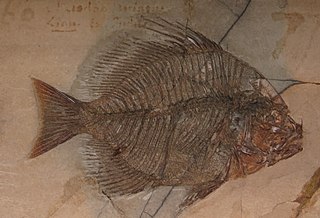
Ceratoichthys is an extinct genus of lookdown-like prehistoric jackfish that lived during the late Ypresian epoch, of the Early Eocene. It contains a single species, C. pinnatiformis of Monte Bolca, Italy. It and Vomeropsis are the only known members of the extinct subfamily Vomeropsinae.

Aeoliscoides is an extinct genus of prehistoric ray-finned fish that lived from the early Eocene. It is known from a single species, A. longirostris, from the famous Monte Bolca site of Italy. It was a member of Centriscidae, making it a relative of modern shrimpfish and snipefish. Its name references its close resemblance to the extant shrimpfish genus Aeoliscus.
Calamostoma is an extinct relative of the ghost pipefish that lived during the early Eocene. It contains a single species, C. lesiniforme from the famous Monte Bolca site of Italy. It is one of the few known fossil ghost pipefishes. Calamostoma and the other Bolca solenostomid, Solenorhynchus, are both placed in the extinct subfamily Solenorhynchinae.
Aulorhamphus is an extinct genus of prehistoric marine ray-finned fish that lived from the early to middle Eocene. It contains four species known from the Early Eocene of Italy and the Middle Eocene of Russia. It was an aulorhamphid, an extinct family of syngnathiform fishes.

Eoholocentrum is an extinct genus of prehistoric marine ray-finned fish that lived during the early Eocene. It contains a single species, E. macrocephalum, known from the Early Eocene of Monte Bolca, Italy. It resembled and was closely related to modern squirrelfishes and soldierfishes, and appears to have been more closely related to squirrelfishes. It can be considered a basal or stem member of the Holocentrinae.
Anguilloides is an extinct genus of prehistoric marine eel that lived in the early Eocene. It contains a single species, A. branchiostegalis. Fossils are known from the famous Monte Bolca site of Italy.

Bolcyrus is an extinct genus of prehistoric marine eel that lived during the Early Eocene. It was a member of the family Congridae, which also contains modern conger eels.
Eoanguilla is an extinct genus of prehistoric marine eel that lived during the early Eocene. It contains a single species, E. leptoptera from the Ypresian-aged Monte Bolca site of Italy. It is thought to have been an early marine relative of the modern freshwater eels.
Bolcanguilla is an extinct genus of prehistoric marine eel that lived during the early division of the Eocene epoch. It contains a single species, B. brachycephala from the Monte Bolca site of Italy. Its exact taxonomic affinities within the Anguilliformes remain uncertain.

Ductor is an extinct genus of prehistoric marine ray-finned fish that lived during the early Eocene. It contains a single species, D. vestenae, known from the famous Monte Bolca site of Italy. It is the only member of the family Ductoridae. It is the earliest representative of the suborder Echeneoidei, and is thought to be most closely related to cobias and dolphinfish.

Acanthonemus is an extinct genus of prehistoric marine ray-finned fish that lived from the early Eocene. It contains a single species, A. subaureus, known from the famous Monte Bolca site in Italy. It is the only genus in the extinct family Acanthonemidae.

Eolactoria is an extinct genus of highly unusual prehistoric boxfish from the Eocene. It contains a single species, E. sorbinii from the Ypresian-aged Monte Bolca site in Italy.

Archaephippus is an extinct genus of prehistoric spadefish that lived from the early Eocene. It contains a single species, A. asper, known from Italy. Several exquisitely preserved fossils have been found from the Monte Bolca lagerstatten. Some juvenile specimens preserve the vertical striped coloration that they would have likely had in life.
Callipteryx is an extinct genus of prehistoric marine trachiniform fish that lived during the early Eocene. It is the only known member of the extinct family Callipterygidae. It is thought to have been a relative of weeverfishes.

Carangodes is an extinct genus of prehistoric ray-finned fish that lived during the early Eocene. It contains a single species, C. bicornis, from the famous Monte Bolca site in Italy. It is the only known member of the extinct perciform family Carangodidae.

Dalpiazella is an extinct genus of prehistoric marine eel from the Eocene of Europe. It contains a single species, D. brevicauda, from the late Ypresian-aged Monte Bolca lagerstatten of Italy. It is though to be closely related to the sympatric genus Paranguilla, with both genera together constituting the family Paranguillidae.

Palimphyes is an extinct genus of marine ray-finned fish known from the Paleogene period. It was a euzaphlegid, an extinct family of scombroid fish related to the escolars and snake mackerels.

Cyclopoma is an extinct genus of marine perciform fish from the Eocene. It is known from the Ypresian to the Lutetian of Europe and eastern North America.
The Eocene-aged Monte Bolca fossil site near Verona, Italy was one of the first lagerstatte to be discovered to science, and still has one of the most prominent vertebrate faunas of all Cenozoic lagerstatte. It has the highest fish diversity of all known Cenozoic fossil sites, with many fossils having extremely detailed preservation. In addition, a very high diversity of marine invertebrates & land plants and a small number of land vertebrates are also known.












